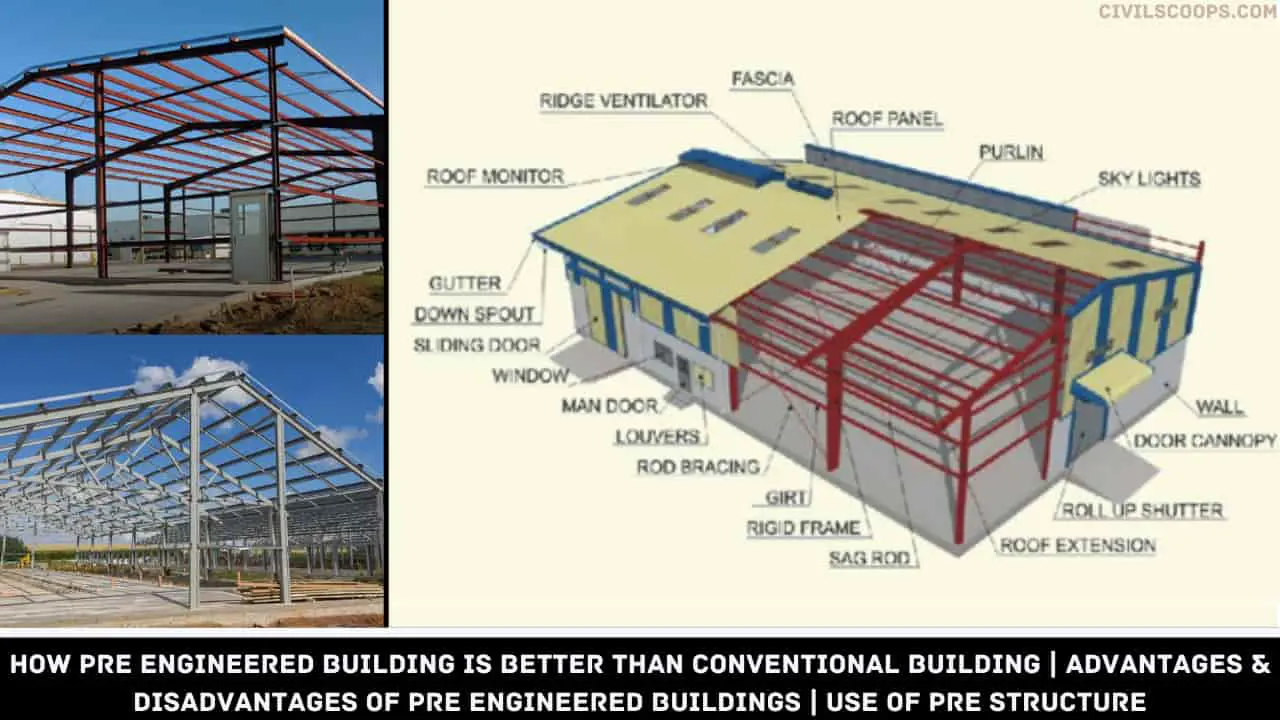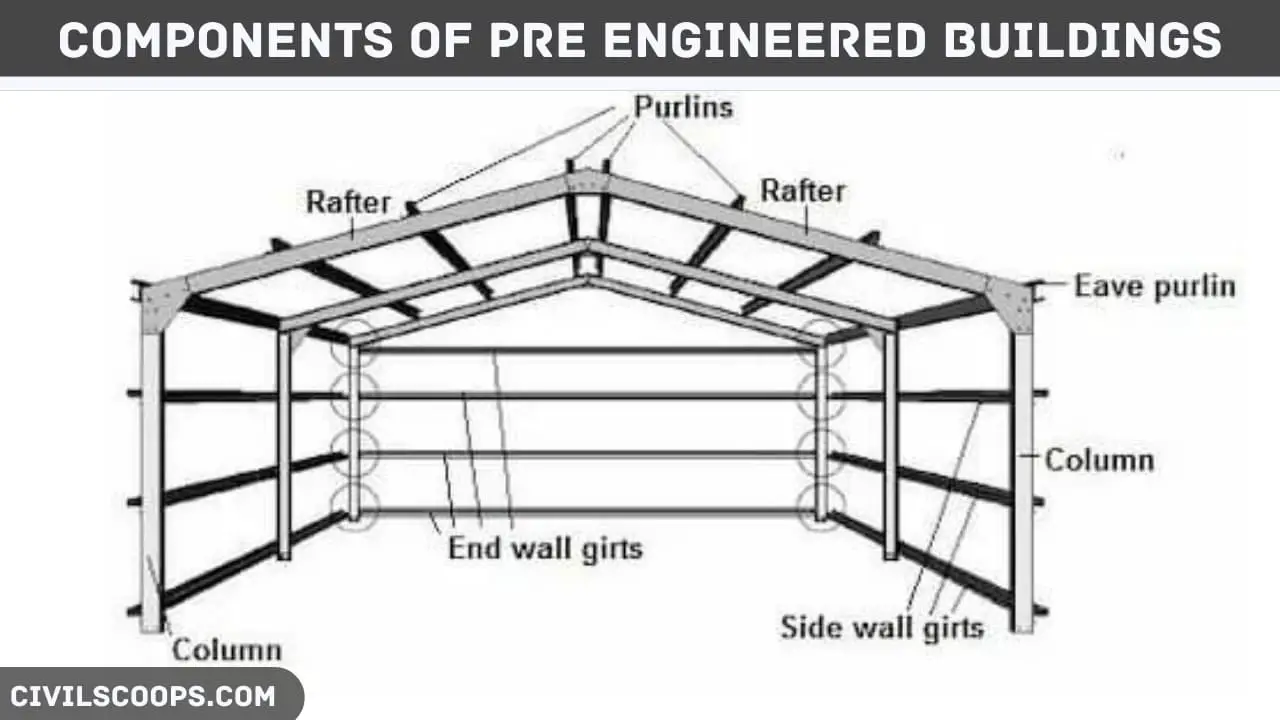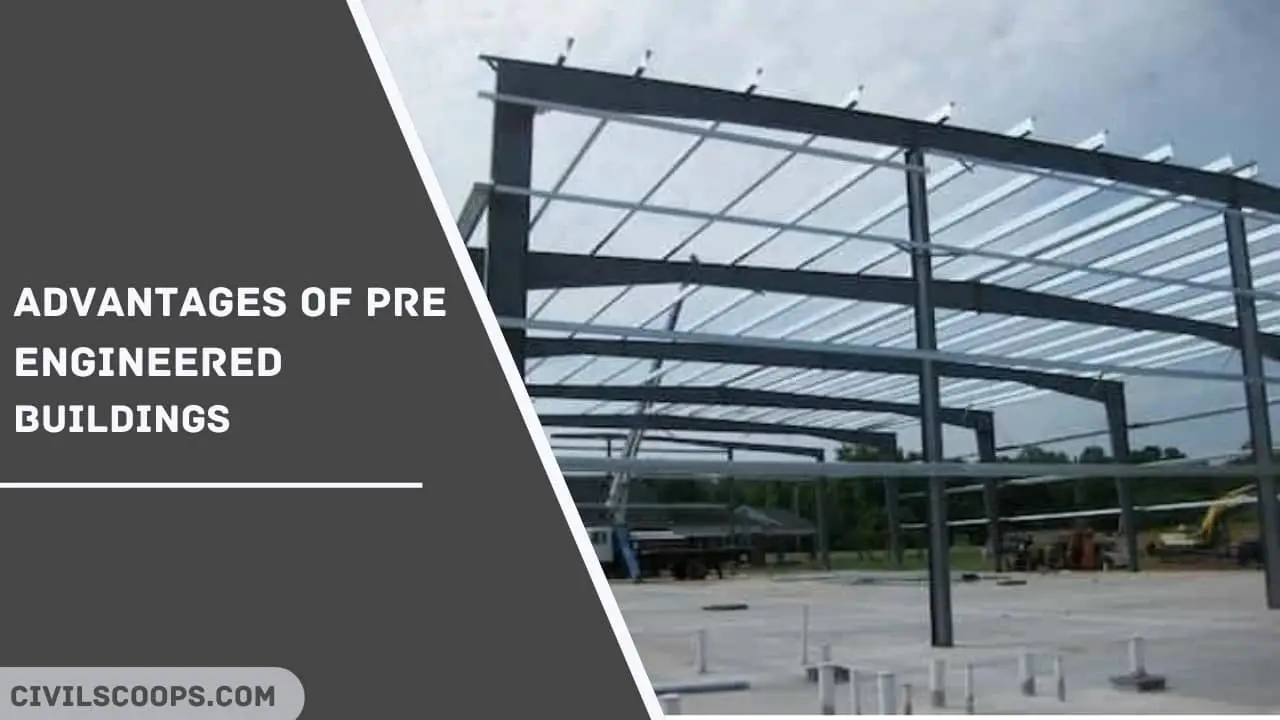How Pre Engineered Building Is Better Than Conventional Building | Advantages & Disadvantages of Pre Engineered Buildings | Use of Pre Structure

Table of Contents
Introduction of PRE Engg Building
The Steel industry is growing rapidly all over the world. Steel is widely used Building material in the construction industry. Nowadays steel structures getting more popularity because of its economy and faster construction. The owner of the example of steel structure is PEB building.
In this article, you will get to know about pre-engineered buildings, its components, advantages and disadvantages. The PEB full form is Pre-Engineered Buildings. The Buildings which are Engineered at the factory and assembled at the site are known as pre-engineered buildings.
The pre-engineered buildings are widely used for the construction of industrial buildings and warehouses metro stations factories and bridges etc. PEB buildings are steel structures which are fabricated at the factory to the required size and dimensions. Pre-engineered buildings at transport it an assembled at site with bolted connections.
Pre-engineered buildings are steel structures from which the structure members are constructed like columns, roof truss, purlins etc. Pre-engineered steel buildings are constructed using Steel built-up sections that are designed and fabricated in the factory and assembled at the site by using various bolted connections.
Pre Engineered buildings have more advantages as compared to conventional Steel buildings.PEB shed is mostly used in the construction of industrial buildings. PEB construction is economical and easier in fabrication. PEB structure can be finished internally to serve the functions which are required in the design of low-rise building.
Components of Pre Engineered Buildings

The pre-engineered building is constructed with different components and connections. Pre-engineered buildings consist of difference structural Steel members which are as follows
1. Primary Frame
The Primary frame which is used in PEB construction is an assembly of built-up sections which forms framing and consists of trusses or castellated beam.
2. Secondary Structural Elements
The secondary structural elements are cold-formed members in the different shapes such as Z and C etc.
3. Roof and Wall Panels
The tin Shades and curtain wall made up of Glass and rolled formed Steel is generally used in roof and wall panels.
4. Sandwich Panels
Sandwich panels are made up of three layers in which an all aluminium core is inserted between two aluminium sheets. Components of Industrial Building
The different components of industrial buildings are as follows.
- Purlins
- Sag rods
- Principal Rafters
- Roof Truss
- Gantry Girders
- Bracket
- Column and Column base
- Girt Rods
- Bracings
Advantages of Pre Engineered Buildings

The various advantages of Pre-engineered buildings are as follows
- Quality control of construction: In the case of the pre-engineered building construction, all the structural members are made in the factory under the supervision of a quality control engineer.
- Economy: The construction of Pre-engineered buildings is less expensive as compared to another type of buildings. Pre-engineered buildings save designing and manufacturing costs.
- Less Maintenance: The maintenance cost which is required for the pre-engineered building is very less as compared to the conventional steel buildings because of the use of high-quality paint.
- Time Required for PEB Construction: The time required for pre-engineered buildings construction is less due to the design of the structural components using advanced software.
- Warranty Period of Pre-Engineered: The warranty period of Pre-engineered building is 20 years given by the manufacturers.
- Erection of Pre-Engineered Building: The erection of Pre-engineered building components is very fast and easy due to the use of Pre-manufactured and skilled labour in pre-engineered building construction.
Also Read: Requirements of Good DPC | Prevention of Dampness | Methods of Damp proofing
Disadvantages of Pre-Engineered Buildings
There are also some disadvantages of Pre-engineered buildings which are as follows.
- This type of structure can be attractive when it is left exposed.
- The parts of the pre-engineered buildings are susceptible to corrosion.
- The insulating of the building will furthermore increase the construction cost.
Use of Pre Structure
The Pre-Engineered buildings are used for the following structures.
- For the Construction of Low Rise Industrial Buildings.
- Power Plants
- Warehouses
- Laboratories
- Airport Hangers
- Parking Lots
- Factories
How Pre Engineered Building Is Better Than Conventional Building?
Pre-engineered metal buildings have efficient design due to its integral framing system whereas the conventional Steel buildings have a less precise design which requires more time.
Pre-engineered Steel buildings are 10 to 20% lighter than conventional buildings. PEB Construction and erection is faster and simple as compared to conventional Steel buildings.
PEB Buildings required light equipment for construction, and conventional building required more labour and heavy equipment for Construction. Pre-engineered buildings have good resistance against systemic actions due to lightweight structure whereas conventional buildings cannot stand against systemic forces because of heavy structure.
Applications of Pre Engineered Buildings
Here, the list for application of pre-engineered buildings are as follows.
- Warehouses
- Factories
- Workshops
- Offices
- Gas Stations
- Vehicle Parking Sheds
- Showrooms
- Aircraft Hangars
- Metro Stations
- Schools
- Recreational
- Indoor Stadium Roofs
- Outdoor Stadium Canopies
- Bridges
- Railway Platform Shelters
Also Read: Skeleton Frame | Building Skeleton | Steel Structural Building
Pre Engineered Building Design Calculations
The pre-engineered building design calculations are done by the main framing of the engineered Building System by the Stiffness Matrix method. The design of the pre-engineered building is based on the allowable stress design as per the American Institute of Steel construction specification.
The design cycle consists of the following steps.
- First upon set up the section of the required size and breast locations based on the geometry and loading.
- Then calculate the shear moment and axial force at each point for each load combination.
- Identify and compute allowable share stress and allowable bending stress in the compression and tension at each analysis point.
- Calculate the corresponding stress ratio for shear and axial and bending based on the allowable stresses.
- Design the optimum location and check whether the predicted size is as per the manufacturing constraints or not.
- At the end of the design process, the analysis of the structure is done for further optimization
Load Calculations for Pre-Engineered Buildings
The load calculations for pre-engineered buildings is that load considered are the same as for general building structure.
- Dead Load Calculations: The dead load includes self-weight of purlin, roof and wall sheeting and other structural components.
- Live or Imposed Load Calculations: This type of load should be considered as per IS 875 (Part 2).
- Wind Load Calculations: Considered the basic wind speed as per the space of the structure. The wind pressure is calculated as per the IS 875 (Part 3)
- Seismic Load Calculations: Earthquake loads can affect the whole structure so that it is necessary to consider it during the designing.
- Load Combinations: As per IS 1893 2002 (Part 1), 7(DL ± LL), 7(DL ± EL) , and 3(DL + LL ± EL)
[su_box title=”FAQ” style=”default” box_color=”#333333″ title_color=”#FFFFFF” radius=”3″ class=”” id=””]
PEB Structure
Pre Engineered Buildings (PEB) are the buildings which are engineered at a factory and assembled at site. Usually PEBs are steel structures. Built-up sections are fabricated at the factory to the exact size, transported to site and assembled at site with bolted connections.
PEB Shed
In structural engineering, a pre-engineered building (PEB) is designed by a PEB supplier or PEB manufacturer, to be fabricated using a best suited inventory of raw materials available from all sources and manufacturing methods that can efficiently satisfy a wide range of structural and aesthetic design requirements.
PEB Full Form
In structural engineering, a pre-engineered building (PEB) is designed by a PEB supplier or PEB manufacturer with a single design to be fabricated using various materials and methods to satisfy a wide range of structural and aesthetic design requirements.
PEB Steel Structure
Pre-Engineered Buildings (PEBs) are the building components that are manufactured at a factory and assembled on site. Usually, PEBs are steel structures and can be an alternative to conventional structural steel buildings.
How Pre Engineered Building Is Better Than Conventional Building?
Pre-engineered buildings are statistically 30% lighter than conventional buildings because of more efficient use of steel. The numbers are more exact, allowing the contractor to purchase less steel and resulting in less waste.
What Are the Advantages of Pre-Engineered Buildings?
Here, the pros of pre-engineered buildings are as follows.
- They are cost-effective.
- They offer time savings.
- They are versatile and offer architectural options.
- They are quality and durable structures.
- They are low-maintenance.
- They are sustainable.
Where is PEB used?
PEB is now used for all type of buildings such as low rise, medium rise and skyscrapers. Due to the attractive features of prefabricated structures, it is taking over traditional construction. All advantages aside, PEB technology provides the much-required design flexibility for steel structures.
Where Are Pre-Engineered Structures Best Used?
Pre-engineered buildings are commonly used for projects in the industrial and commercial sectors such as: mining, oil and gas, retail, construction, recreation, agricultural uses, and many more applications.
Pre Engineered Building Components
- Foundation & Floor Line: Metal buildings are secured onto a poured concrete foundation.
- Corner Columns: Corner columns are erected vertically into the four corners of the concrete foundation to support each corner of the building.
- Eave Struts: In addition to connecting to the endwall rafters, corner columns also connect to eave struts which run the length of the building horizontally.
- Endwall Columns & Endwall Rafters: Endwall columns add structural support to the front and back of the building. Endwall columns are located at the ends of the metal building and are secured vertically into the concrete foundation at the ground and the endwall rafters overhead.
- Frame Columns & Frame Rafters: Frame columns provide additional structural support to the sides of the building and are secured into the poured concrete foundation vertically.
- Sidewall Girt: Sidewall girts and endwall girts are horizontal members that add additional structural integrity.
- Endwall Girt: The endwall girt functions the same as the sidewall girt but is located at both ends of the metal building. Endwall girts span horizontally across from one corner column to the other at the ends of the building. Endwall girts attach to corner columns and endwall columns.
- Rod Braces/Cross Bracing: Rod braces are the members that form an X between columns and between rigid frame rafters to provide structural integrity. Braces are secured to the columns along the sidewalls and across the roof.
[/su_box]
[su_note note_color=”#F2F2F2 ” text_color=”#333333″ radius=”3″ class=”” id=””]
Like this post? Share it with your friends!
Suggested Read –
- All About Formwork Failure | What Is Formwork Failure | Causes of Formwork Failure
- All About Plywood | What Is Plywood | What Is Plywood Used For | What is Plywood Made From
- All About Consider | When Building a New Home | Important Factors to Consider When Building a New Home
- All About Flagstone | Introduction of Flagstone | What Is Flagstone | What Is a Flagstone Patio | Types of Flagstone
- All About Painting | What Is Painting | Painting Area Calculation for Evan Surface & Uneven Surface |How Much Paint Do I Need
[/su_note]
Originally posted 2022-07-17 12:22:47.
